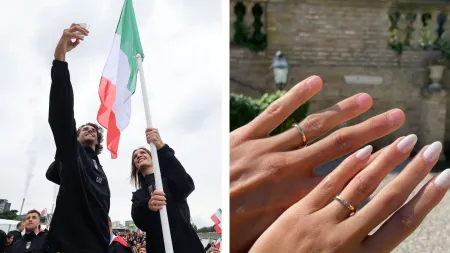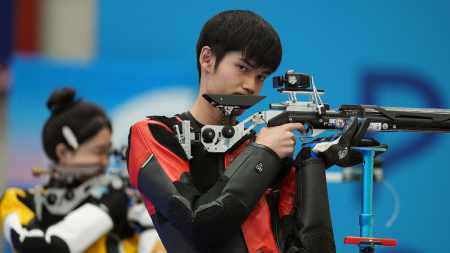40 LED lights, a cloud of water-vapour for illumination, 200 high-pressure misting nozzles: How flying cauldron of Paris Olympics is lit up
Such was the visual appeal of the moment that even the sparkling Eiffel Tower had to fight for attention on Friday night.
On Saturday, a day after the Opening Ceremony on the River Seine, tourists walked past the Louvre and Place de la Concorde as if they were any other monuments.

There is a new attraction in town. Sandwiched between the museum and the historic square, the centuries-old Jardin des Tuileries has been the site of tranquillity amidst the more famous tourist traps. That won’t be the case anymore — at least for the next fortnight.
The garden will be the home to a hot-air balloon, in which rests the Olympic cauldron which made a spectacular first flight across the sky over Paris on Friday night in a stunning finale to the opening ceremony.
Every evening when brightly lit, from sunset until 2 am, it’ll hover over the garden, 60 metres off the ground. During the daytime, 10,000 free tickets will be issued to approach the ceremony’s showpiece, whose launch site is near the glass pyramid of the Louvre Museum. This is the first cauldron in Olympic history to light up without the use of fossil fuels. It, instead, depends on water and electric light.
Seven metres in diameter, the ring at the base of the balloon has 40 LED lights installed in it. They illuminate a cloud of water vapour produced by 200 high-pressure misting nozzles, which give the flickering and smoke effect of real flames. The electricity and water supply are supplied from the ground to the airborne balloon structure.
The designer Mathieu Lehanneur — hailed as an ‘inescapable figure of French design’ and chosen for his ‘poetic approach’ and depicting ‘symbolic force’ — had pledged to create something that was never seen in Olympic history.
 Paris 2024 Olympics – Opening Ceremony – Paris, France – July 26, 2024. Torchbearers Teddy Riner and Marie-Jose Perec light the Olympic cauldron during the opening ceremony. (REUTERS/Marko Djurica)
Paris 2024 Olympics – Opening Ceremony – Paris, France – July 26, 2024. Torchbearers Teddy Riner and Marie-Jose Perec light the Olympic cauldron during the opening ceremony. (REUTERS/Marko Djurica)
The cauldron, Paris 2024 organising committee chief Tony Estanguet served two purposes — to wow people and also underline their ambitions for a low-carbon Olympics. This, he said, was ‘one of the main symbols of the Games.’’
“We wanted the cauldron to use a new technology in order to not produce too many emissions. We were ambitious and we wanted to bring together something spectacular and environmental responsibility at the same time,” Estanguet was quoted as saying by the Associated Press.
In the days leading up to the July 26 ceremony, the buzz around the ‘mysterious balloon’ had been building up across the city. After its first flight during Friday’s opening, when the montgolfière soared up to 1,000m to light up the night Parisian sky, it has only multiplied.
Held along the River Seine, the ceremony — held for the first time outside a stadium — was replete with moments of wow and surprise. However, the lighting of the cauldron, as is the tradition, was one of the most thrilling and dramatically choreographed segments.
Everything that took place during the four-hour show was building up to the finale which, like other elements of the ceremony, was a nod to French cultural aspects.
Right from the mysterious torchbearer who appeared in a hooded, masked costume, parkouring over the rooftops of the architectural marvels that flank the river.
The masked man was a salute to Assassin’s Creed, the famous video game developed by a French company. One of the game’s installments is set in Paris and the creators have also donated $500,000 towards the rebuilding of Notre Dame.
 A torch bearer runs atop the Musee d’Orsay, in Paris, France, during the opening ceremony of the 2024 Summer Olympics, Friday, July 26, 2024. (AP/PTI)
A torch bearer runs atop the Musee d’Orsay, in Paris, France, during the opening ceremony of the 2024 Summer Olympics, Friday, July 26, 2024. (AP/PTI)
It was also a reference to some of the famous French figures, including the Man in the Iron Mask — the titular character from the Phantom of the Opera, Belphegor and the ‘gentleman thief’, Arsene Lupin.
The torchbearer started from Musee d’Orsay, sprinted along the Pont Neuf bridge, rode a boat with a child holding the flame and cartwheeled down a runway.
The mystery man carried the torch up to the Eiffel Tower, and it was assumed that’s where the flame would be lit. Tradition would have dictated that; after all, the flame is usually positioned near one of the main venues. France, though, did not want to ‘be like everyone else’.
So, in a dramatic twist, the torch made the journey a return journey on the boat. In a carefully designed climax, the lighting of the cauldron began with wheelchair-bound Charles Coste, the oldest living French Olympian at 100 years old passing the torch to the host nation’s athletes Marie Josée Pérec and Tony Riner for the final act.
Olympics 2024- Paris 2024, India's schedule for Day 1
- Why those who called Biles a 'whiny quitter,' Vinesh a 'khota sikka' are nervous
- Olympics begin with boat party
As they lit the flame, the cauldron rose above the ground in a hot air balloon, in an ode to the first manned flight in a hydrogen-filled gas balloon by the Montgolfier brothers in 1783 at the same location.
All day, the caldron will be tethered at its place in the garden. But when the sun goes down, it’ll rise into the air, illuminating the sky of this city of lights.
Disclaimer: The copyright of this article belongs to the original author. Reposting this article is solely for the purpose of information dissemination and does not constitute any investment advice. If there is any infringement, please contact us immediately. We will make corrections or deletions as necessary. Thank you.





